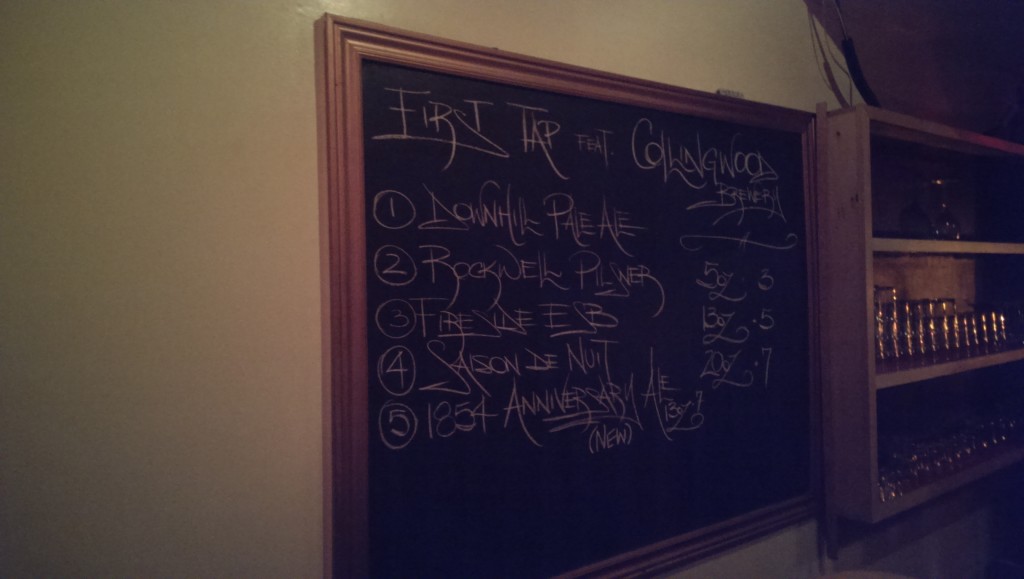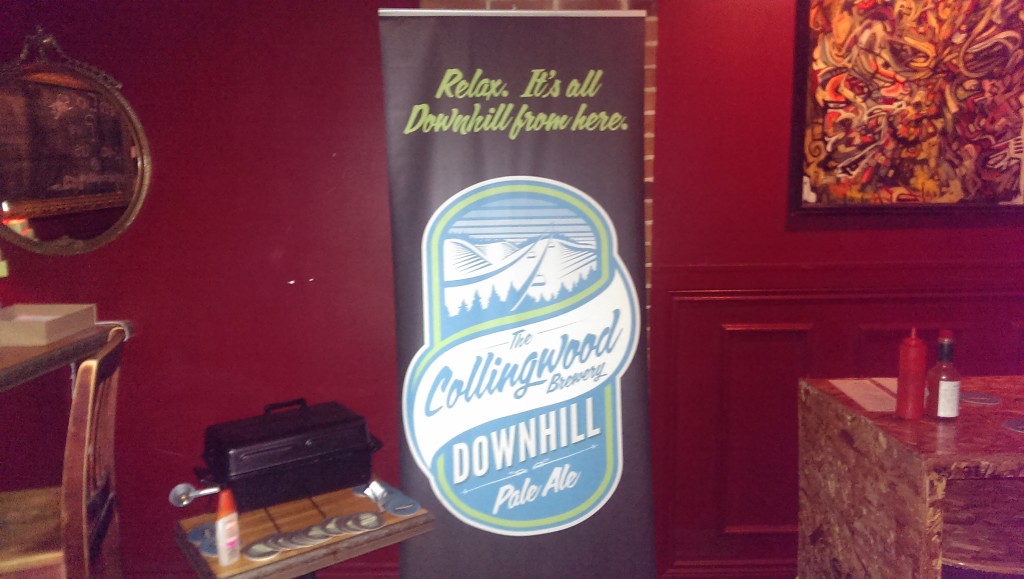The second floor of Tequila Bookworm on Queen Street West is a good location for a tap takeover. For one thing, in order to be able to attend such an event, you have to know about its existence. You’d be forgiven for bypassing it completely on the way into the main bar area on the first floor. I was invited by Mick McNamara, until recently a blogger under Hopgobblin’ to come on out and try beer made by his new employer, The Collingwood Brewery. If you read last Friday’s post as he had done, you probably appreciate that that’s a brave move.
In the past, I’ve tried Collingwood’s Downhill Pale Ale from cans in the LCBO. If you don’t get up to the Collingwood area, it’s likely that is the extent of your experience with them as well. While it’s nice that there are breweries opening all over Ontario, it does make a top down view of everything happening quite difficult to maintain.
The brewer at Collingwood is Chris Freeman, a graduate of the Niagara College program. As yet, it’s a small operation. They seem to be on tap at something like 70 locations in Ontario (including the schnitzelicious Alphorn in Collingwood) and selling Downhill cans out of 76 LCBO stores. That’s quite an impressive territory for a brewery this young.
Perched on the barstool, looking around the room, it became apparent that the development of the brewery has acquired a noticeably schizophrenic tendency. On the one half of the room, there’s the Collingwood lifestyle brand which has replaced the wooden floor temporarily with a nearly vibrant lawn of astroturf. On the other half is a blackboard listing a Black Saison and a Barrel Aged Saison.

I should point out that one of Tequila Bookworm’s great strengths is their blackboard script. If you glance it on social media you never wonder which bar it is.
I like Collingwood’s branding. The advantage being taken of the connotation of Collingwood’s activities and the skiing and outdoor lifestyle. Frankly, “It’s all Downhill from here” is the kind of slogan of which a proper ad agency would be proud. In a market where your immediate competition is Side Launch (High quality core brands without much room for experimentation) and Northwinds (Lots of experimentation, but no canned or bottled core brands) it makes sense to play to the cottagers and the moguls on the moguls. During the winter the brewery hosted a Helly Hansen clothing sale. That’s the audience.
The beers that are consistent with the branding are Downhill Pale Ale and Fireside ESB. Downhill Pale Ale successfully walks a line at 5.4% between accessibility for new beer drinkers that might be trying out the local product and a surprising amount of character. The only difficulty is that the hopping is relatively subtle so the beer needs to warm significantly before it develops substantial aroma (perhaps the taps at Tequila Bookworm are being kept slightly too cold). I know that in the canned version, the hops (Amarillo leading others according to Freeman) are more pronounced.
The Fireside ESB does many of the things an ESB should including a certain amount of caramel through the body and enough roast to reinforce it without becoming assertive. I suspect that it would be a very versatile beer for food pairing. I think it an Americanized ESB and it lacks a certain amount of the earthy, funky English yeast character if we’re judging to style. I’d bet the folks in Collingwood drinking it apres-ski prefer it this way, making it the right choice for a growing brewery.
A third year round brand recently introduced is the Rockwell Pilsner. At 4.6% and touting itself as a Czech Style Pilsner, this is the least accomplished of the core offerings. The hopping is relatively minimal at 28 IBU and in discussion Freeman denoted the use of Saaz. The Saaz, typically floral and peppery in a Pilsner is subdued here. The Collingwood water is, according to municipal websites, relatively hard. It seems to me compensatory late hop additions would help here. Perhaps because of the lessened hop character, the yeast esters emerge more fully and for that reason I wonder whether the fermentation was toward the upper temperature range for a lager. The fruitiness here is so like a Cream Ale that the beer doesn’t really read as a Pilsner. Rockwell needs tweaking which I’m sure it will get in future.
The two Saisons on offer are the black Saison du Nuit and the 1854 Anniversary Saison. These beers are conceptually misaligned with the larger brand of the brewery and, independent of that quibble, were the least successful of the five offerings. The Saison du Nuit came across aromatically as extremely phenolic and retronasally created a lingering impression of Sunlight Soap Bubbles. There is also clove from the yeast and roast from the grist, but overwhelmingly the impression is of disharmony. According to Freeman the batch was a single brew from back in January and the malt flavours are only now coming to the fore. What must it have been like in January? The 1854 Anniversary Saison was aged in Pinot Noir barrels from the Tawse Winery and began successfully with oaky notes and vanilla but contained a distracting frisson of uncooked pumpkin or gourd around the edges that was inescapable once experienced. Neither of these beers inspire much confidence. To be fair, both Saison and Barrel Aging have steep learning curves so it may be unrealistic to expect greatness a year out of the gate.
I think if I were Collingwood, I would stick to the core mission statement. Continue to expand Downhill Pale Ale, push to get Fireside into the LCBO (bolstered by last week’s CBA), refine all three core brands so that they become more themselves. If your target market is the weekend warrior it doesn’t do to show anything but strength.

Strange, I thought the saison du Nuit was great from the bottle, phenolic and spicy, roasty, but no soap. And the Saison won a silver at CBAs. Were your samples bottle or draught?
Draught. Sorry that the response took a while. For some reason the comment ended up in the spam filter.